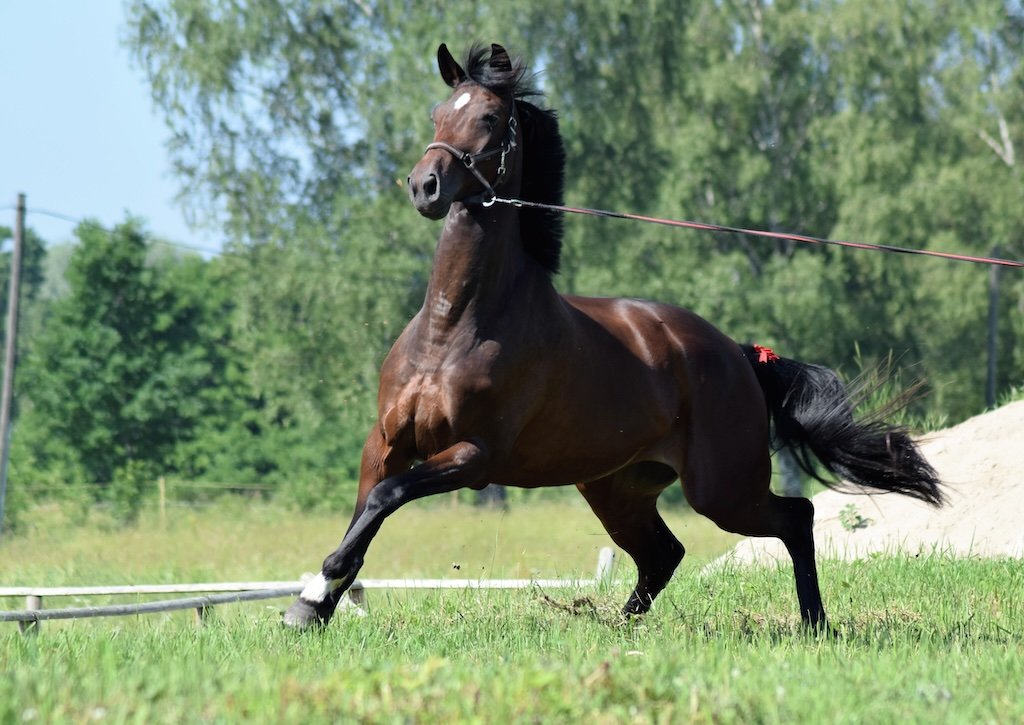5 groundwork mistakes to avoid
Groundwork is an excellent tool if used properly. Here are 5 common mistakes that compromise the beneficial effects of this kind of work.
Make sure to only work the horse for as long as he is physically and mentally focused.
Groundwork is an amazing way to teach good posture, develop muscles and coordination and improve communication between horse and rider. It is great for teaching young horses how to carry themselves correctly, keeping older horses fit and correcting issues the horse might have when ridden. Groundwork can be a great tool, but it can also be a way to ruin a horse. This is why it is essential to do it correctly. Here are some common mistakes to avoid when doing any kind of groundwork with your horse.
1. Sessions are too long. When it comes to groundwork, more is not necessarily better. Often, I see horses start off a groundwork session focused, in good posture and willing to work, but by the end of it, their focus is gone and their posture has deteriorated. Keep in mind that even though groundwork might seem like an easier task than ridden work, it is still work and it requires a lot of mental and physical energy. A 45-minute session that starts off with 15 minutes of good posture and ends up with 20 minutes of poorly executed exercises and bad movement, is nowhere near as productive as a good, 15-minute-long session. If we're doing groundwork to develop coordination and posture, 15–20-minute sessions are more than enough. Keep the sessions short, and only work the horse as long as he is physically and mentally focused.
Before introducing bending, make sure the horse knows how to carry himself in a straight line.
2. Too much focus on bending. Yes, the ability to laterally flex is important for a riding horse, but obsessing over the bend can be very counterproductive. I see many horses being forces to start laterally bending before they are ready for it. In the beginning, teaching the horse how to move on straight lines is much more important. If you're working the horse on a circle, make sure it is big enough so the horse can handle the bend. Small circles should be reserved for horses who have already developed enough strength and coordination to carry themselves properly on straight lines and big circles. If you rush and ask the horse for too much bend when he is not yet ready for it, you are bound to create compensation patterns.
3. Infrequent breaks. As mentioned, groundwork is demanding both mentally and physically, so never forget to take frequent breaks. Even if you're only working in walk, focusing on posture and correct muscle activation, take frequent breaks during this kind of work. When learning new movement patterns, the nervous system is working overtime, and will need a break quite often. With new movements, take a short break every three repetitions. It doesn't have to be long, just enough for the horse to completely relax. This way he will be able to integrate new concepts into his movement more easily.
After two or three repetitions of a difficult exercise, take a break and allow the horse to relax.
4. Exercises that are too demanding. Because groundwork is not as exciting as ridden work, people like to spice it up by adding different kinds of exercises to the mix. This is great, but we do sometimes tend to go overboard. Cavaletti is a great example of this. When asking the horse to work over poles or cavaletti, we often don't give them enough time to master one exercise before moving on to the next one. Ground poles are followed by cavaletti, followed by combinations of 4, 6 or 8 of them, cavaletti on a circle, cavaletti in all gaits... This is a lot. Of course, all of these exercises can be great, but don't try to shove them all in a single session. Especially if you are dealing with a young horse. If your horse is a seasoned professional, by all means, vary the exercises and challenge him, but if he is still learning how to tackle ground poles and cavaletti, take it easy and give him time to work out how to use his body in each specific exercise.
If the horse is anxious, the work should be focused on building trust and calming down. Working in an overly active sympathetic state has zero benefits.
If the horse is anxious, the work should be focused on building trust and calming down. Working in an overly active sympathetic state has zero benefits.



